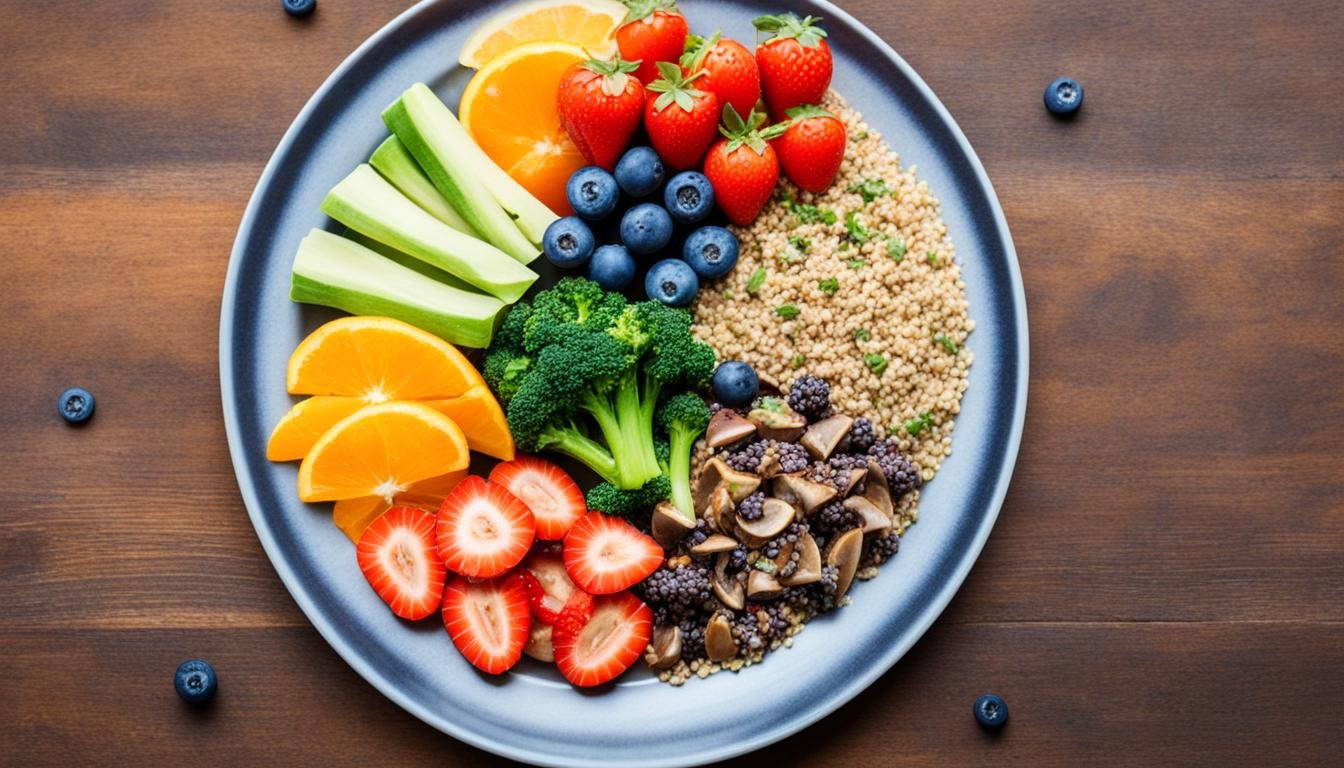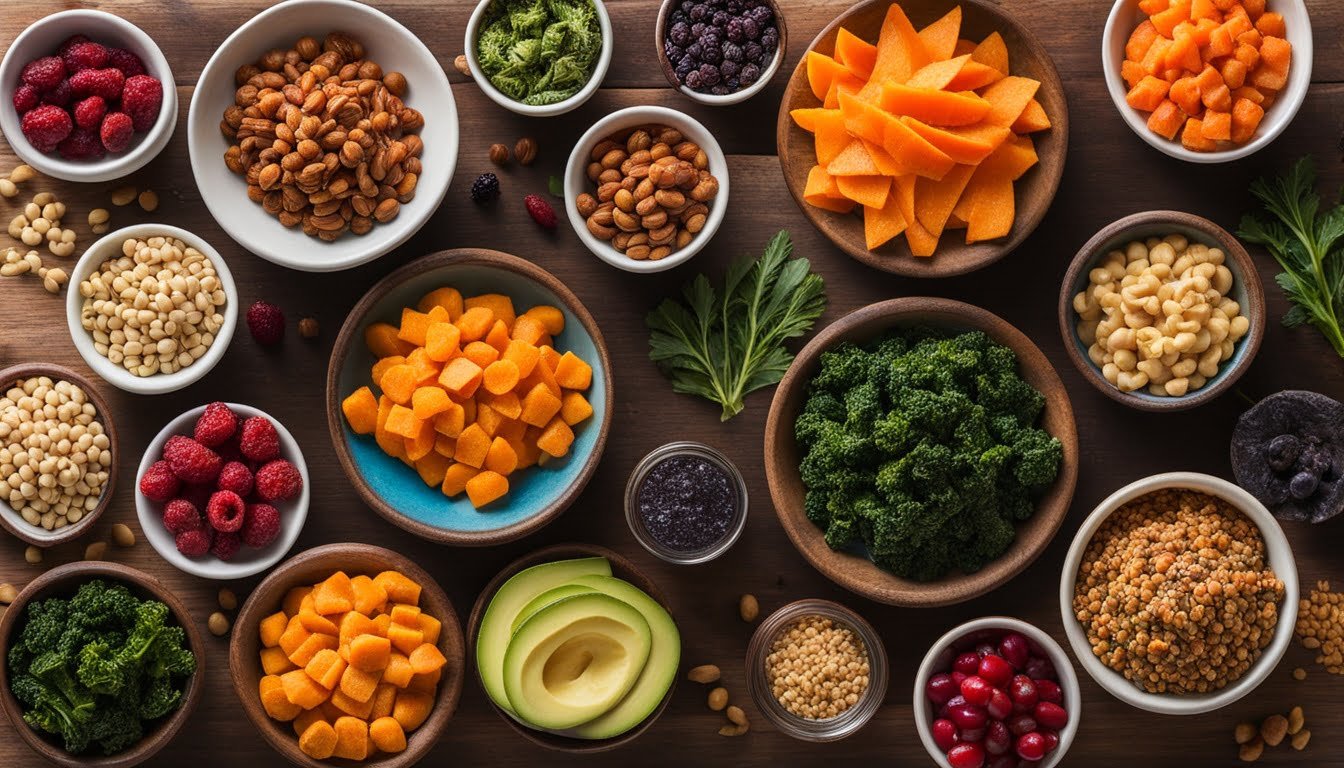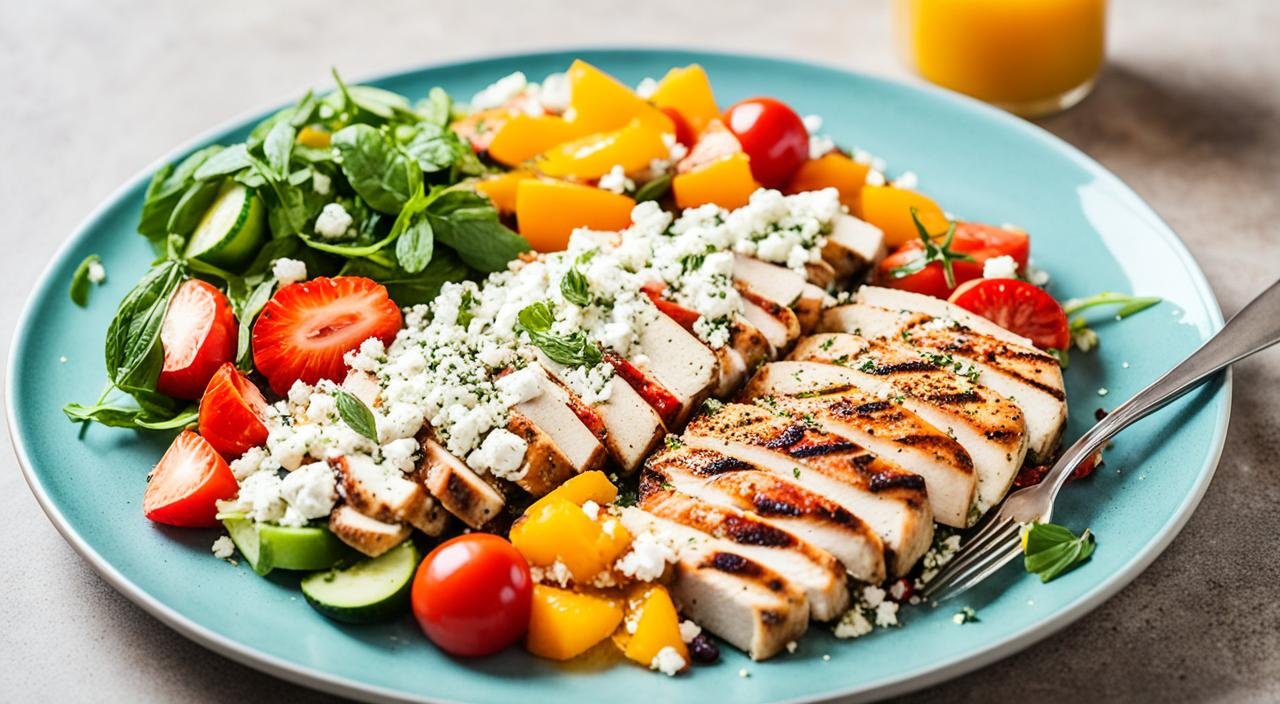Did you know, a 2019 review found that up to 5% choose a gluten-free diet by choice? Another 13% feel they are sensitive to gluten-containing products. Key motivation aside, starting a gluten-free diet properly ensures you stay happy, healthy, and full. A gluten-free diet mainly focuses on simple, natural foods. Think of colorful fruits, veggies, beans, nuts, seeds, fish, and lean meat. Grains like rice, quinoa, and buckwheat are also perfect choices.
But, be careful. It’s common to turn to gluten-free packaged foods, which might not always be the healthiest option. These can be high in sugar and calories, which could lead to gaining weight. So, it’s best to enjoy gluten-free packaged foods as treats, not as daily meals.
Key Takeaways
- Up to 5% of the population follows a gluten-free diet by personal preference.
- Filling your plate with naturally gluten-free whole foods is key.
- Gluten-free packaged foods should be considered occasional treats.
- A balanced gluten-free diet can be healthy and satisfying.
- Consulting a registered dietitian can help ensure nutritional needs are met.
So, what are the sneaky sources of gluten that could catch you off guard? Knowing these hidden sources can make living gluten-free easier and more confident.
What is Gluten and Why Avoid It?
Gluten is a group of proteins in wheat, barley, rye, and spelt. It makes dough sticky when water is added. This makes bread rise and gives it a chewy texture. But, some people feel bad after eating gluten. They might choose a gluten-free lifestyle.
Understanding Celiac Disease
Celiac disease is when the body fights itself after eating gluten. This happens in the intestines. About 1% of Western people have it.
Non-Celiac Gluten Sensitivity (NCGS)
Some people have non-celiac gluten sensitivity (NCGS). It affects 0.6%-13% of the population. They feel sick after eating gluten. This happens even if they don’t have celiac disease or a wheat allergy.
There is a thin line gap between these two terms. Know the key differences between “Celiac Disease vs Gluten Sensitivity” But accompanying with that, you should have the knowledge of signs to watch “Celiac Disease Symptoms.”
Wheat Allergies and Gluten Ataxia
Wheat allergy makes some people break out in hives or have trouble breathing. Gluten ataxia is rare. It causes the immune system to hurt the nervous system after eating gluten. This leads to trouble with balance and movement. It mostly affects people over 50.
Identifying Gluten-Containing Foods
Avoiding gluten completely is tough. It’s in many common foods and drinks. Knowing where gluten comes from is key for a gluten-free diet. The main source is wheat, which includes many kinds. Other grains like barley and rye have gluten too.
Common Sources of Gluten
Wheat-based items like bread and pasta are clear sources of gluten. But, gluten sneaks into things like soy sauce and malt vinegar. Oats can be a problem if they touch gluten in processing.
Unexpected Gluten Sources
To avoid unexpected gluten, always check labels. Just because something is “wheat-free” doesn’t mean it’s gluten-free. You must be careful at the store to miss gluten accidentally.

Building a Gluten-Free Pantry
Making the switch to a gluten-free diet is both smart and gratifying. You should stock up on foods that are naturally gluten-free. This will make your meal planning and cooking fun and lasting.
Fruits, Vegetables, and Lean Proteins
Make sure to include fresh fruits, vegetables, meat, and more in your pantry. These items are full of nutrients and don’t have gluten. They help keep you healthy.
Gluten-Free Grains and Flours
Also, fill your shelves with gluten-free grains like quinoa and brown rice. They’re great for making meals. Don’t forget about gluten-free flours for baking, such as tapioca and almond meal.
Reading Food Labels Carefully
Reading food labels is very crucial when looking for gluten-free items. Always check for a “gluten-free” label. This means the product follows strict FDA guidelines. Be aware of possible gluten exposure from shared facilities. Staying sharp helps you keep a true gluten-free life.
Gluten Free Diet Plan For Beginners
Starting a gluten-free diet is a big change. But, doing it right can be both fulfilling and healthy. The key is to plan balanced meals that provide all your nutrient needs.
Creating a Balanced Meal Plan
When you plan your meals, focus on a mix of gluten-free meal planning options. Add fresh fruits, veggies, lean proteins, and gluten-free grains. This keeps your balanced gluten-free diet rich in vitamins, minerals, and other nutrients. Try to limit gluten-free packaged foods. They often have lots of calories, sugar, and carbs.
Meal Prep and Batch Cooking
Make life easier by adding gluten-free meal prep and batch cooking to your routine. Cook things like roasted veggies, grilled chicken, and gluten-free grains ahead of time. This way, you can quickly put together healthy meals. It saves time and keeps you from choosing not-so-healthy gluten-free packaged foods when busy.

With a focus on a balanced gluten-free diet and smart gluten-free meal prep and batch cooking, it’s easier to switch to a gluten-free diet plan for beginners and stick with it.
Dining Out Gluten-Free
Eating out gluten-free is a challenge, but doable. It’s crucial to ask questions and watch for cross-contamination. Ask how dishes are prepared. Like, is the dressing from a bottle or made there? Are the fries made in the same oil as breaded stuff? Also, check if the gluten-free pasta is cooked with regular pasta. While gluten-free menus help, they might not always be accurate. Being your own advocate and looking out for shared cooking spaces is key.
Asking the Right Questions
When at a restaurant, asking the right questions is key to a gluten-free meal. Ask about how the food is prepared, focusing on shared cooking risks. Ask if sauces and marinades could have gluten. Check if the fries share oil with breaded items, and if the gluten-free pasta gets cooked separately.
Cross-Contamination Concerns
Even with a gluten-free menu, watch for cross-contamination. Cooking tools, surfaces, and fryer oil might contain gluten. Tell the waiter clearly about your needs. Ask how the restaurant ensures gluten-free orders are safe. If you feel uncertain, it’s okay to choose a different place that can guarantee your safety.
- It’s good to know which foods have gluten.
- You might want to try millet in your meals.
Gluten-Free Recipes and Meal Ideas
Starting a gluten-free lifestyle doesn’t mean you have to give up delicious meals. A thoughtful gluten-free diet can offer both nutrition and taste. Look no further if you need gluten-free breakfast recipes, gluten-free lunch and dinner ideas, or tasty gluten-free snacks and desserts.
Breakfast Options
Begin your mornings right with our gluten-free breakfasts. A bowl of gluten-free oatmeal with berries, nuts, and honey is a great choice. Or try a vegetable frittata for something savory. Smoothie fans will love our gluten-free protein powder drink with fruits and greens.
Lunch and Dinner Recipes
There’s a lot to pick from for gluten-free lunch and dinner. Cook your favorite meats and fish with roasted veggies. Mix in some gluten-free grains for a balanced meal. A gluten-free pasta dish or stew can be very comforting too.
Snacks and Desserts
Snacks and desserts fit well in a gluten-free life. Enjoy gluten-free baked goods or fruits with nut butters. Even yogurt parfaits or gluten-free smoothies can be a good option.
Sticking to gluten-free meals means choosing whole foods and safe ingredients. Stay creative and you’ll see, a gluten-free life can be diverse and fulfilling.
Managing a Gluten-Free Lifestyle
Starting a long-term gluten-free lifestyle may need some changes. Yet, it brings rewards and health benefits. It’s good to connect with others through a local gluten-free support group or online. This way, you can share info and get help about gluten-free-friendly places to eat and recipes.
Working with a dietitian is key, especially for medical reasons. They ensure you meet your nutrition needs. This step is vital for those with celiac disease. They might lack nutrients like fiber and vitamins.
With a good plan and help, going gluten-free can be both easy and fun. Connecting with the gluten-free community and healthcare experts is important. This way, you can handle the difficulties and enjoy the benefits of this lifestyle.
I’m Dr. Shivani, a Kolkata-based nutritionist since 2015. After 10 years of igniting a love for healthy eating in young minds as a High School nutritionist teacher, I now help individuals unlock their full potential through personalized diet plans. My passion for writing and sharing nutrition knowledge (through blogs and observations) keeps my practice fresh and fuels my love for the field!







